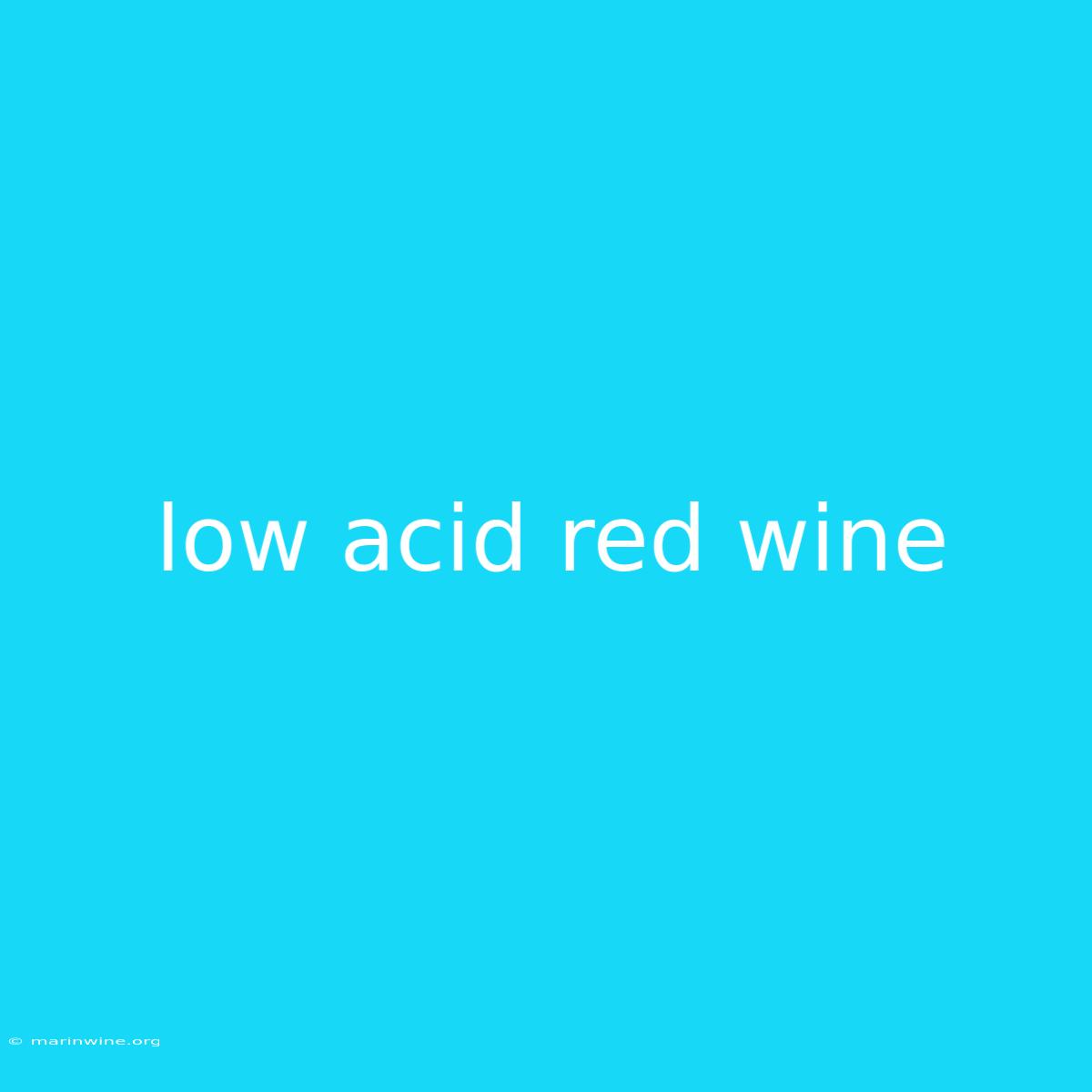Uncorking the Secrets of Low Acid Red Wine: A Journey into Flavor and Health
Have you ever sipped a red wine that felt a little too sharp, a little too tangy? That's likely due to its acidity. But fear not, wine lovers! There exists a world of low acid red wines, offering a smoother, more approachable experience.
Why It Matters: Understanding low acid red wine is key for any wine enthusiast. Whether you're navigating a bustling wine store, exploring new regions, or simply looking for a wine that sits comfortably on your palate, this knowledge empowers you to make informed choices. This article dives into the intriguing world of low acid red wines, exploring their unique characteristics, health benefits, and how to find the perfect bottle for your taste.
Key Takeaways of Low Acid Red Wine
| Feature | Description |
|---|---|
| Taste Profile | Softer tannins, reduced sharpness, smoother finish. |
| Health Benefits | Potential for lower heartburn risk, better digestion, and antioxidant properties. |
| Regions & Varieties | Southern climates, warmer regions, grape varieties with lower acidity (e.g., Grenache, Merlot, Zinfandel). |
| Pairing Considerations | Pair well with richer, heavier dishes like grilled meats, stews, and pasta with creamy sauces. |
What is Low Acid Red Wine?
Red wine's acidity comes from the grapes themselves, influenced by factors like climate, soil, and variety. Low acid wines possess lower levels of tartaric acid, resulting in a more mellow flavor profile.
Key Aspects of Low Acid Red Wine:
1. Flavor Profile:
- Softer Tannins: The tannins in red wine, responsible for its astringency, are often less pronounced in low acid wines, resulting in a smoother, more velvety mouthfeel.
- Reduced Sharpness: The absence of high acidity translates to a less acidic, less piercing taste.
- Balanced Flavors: Low acidity allows other flavors to shine, highlighting fruit notes, spices, and oaky nuances.
2. Health Benefits:
- Potential for Lower Heartburn Risk: High acidity can trigger heartburn, making low acid wines a better choice for those sensitive to stomach discomfort.
- Improved Digestion: Low acidity promotes easier digestion for some individuals, especially those with digestive sensitivities.
- Antioxidant Properties: Like all red wines, low acid wines are rich in antioxidants, beneficial for overall health.
3. Grape Varieties and Regions:
- Southern Climate Grapes: Regions with warmer climates tend to produce grapes with lower acidity.
- Low Acidity Varieties: Some grape varieties are naturally lower in acid, including Grenache, Merlot, Zinfandel, and Barbera.
- Regions to Explore: Southern Italy (Sicily, Puglia), Spain (Priorat, Rioja), and California (Central Coast, Lodi) produce a diverse range of low acid red wines.
Finding the Perfect Low Acid Red Wine:
1. Consult a Wine Expert: Wine shops and restaurants often have staff knowledgeable about acidity levels, enabling them to recommend wines that suit your preferences. 2. Explore Wine Reviews: Websites and online forums dedicated to wine reviews can provide insights into acidity levels and flavor profiles. 3. Experiment with Regions and Varieties: Embrace the adventure of trying different wines from regions known for lower acidity and exploring various grape varieties.
FAQ for Low Acid Red Wine:
Q: Can I "fix" high acidity in red wine? A: While adding water or sugar can dilute the acidity, it can alter the wine's balance. It's best to opt for wines with naturally lower acidity.
Q: Is low acid wine better for me? A: It depends! If you enjoy a crisp, tangy wine, you might not appreciate low acidity. However, if you find high acidity bothersome, low acid wines can be a more enjoyable experience.
Q: Can low acid wines age well? A: Yes, many low acid wines can age well, though some may develop more quickly than their higher acidity counterparts.
Q: Are all red wines from warm regions low acid? A: Not necessarily. Winemaking techniques, soil composition, and other factors can influence acidity levels even in warmer climates.
Tips for Enjoying Low Acid Red Wine:
- Serve at a slightly cooler temperature: Chilling low acid wines can enhance their fruitiness and freshness.
- Pair with rich foods: Low acid wines complement hearty dishes like lamb, grilled meats, and pasta with creamy sauces.
- Explore different aging styles: Some low acid wines are best enjoyed young, while others benefit from aging in oak barrels.
Summary of Low Acid Red Wine:
This exploration into the world of low acid red wine has uncovered the nuances of flavor, health benefits, and the key factors to consider when choosing a bottle. From the smooth tannins to the balanced flavors, low acid wines offer a unique and approachable experience for every wine lover.
Closing Message: The next time you're selecting a red wine, remember to consider the impact of acidity. Embrace the exploration of low acid wines, and discover the delightful world of smooth, approachable, and flavorful reds.

